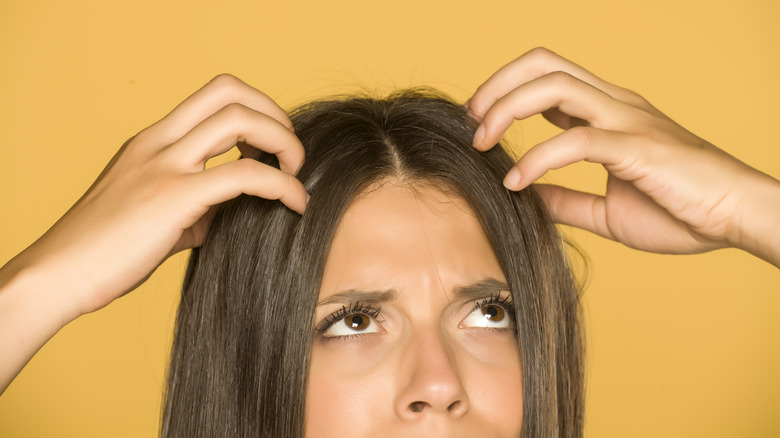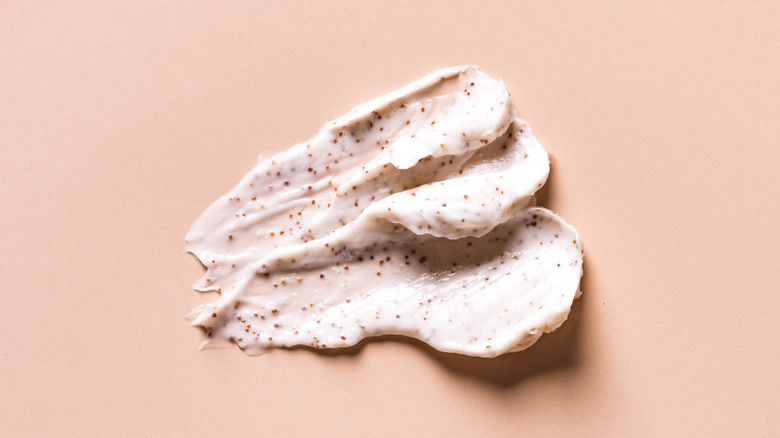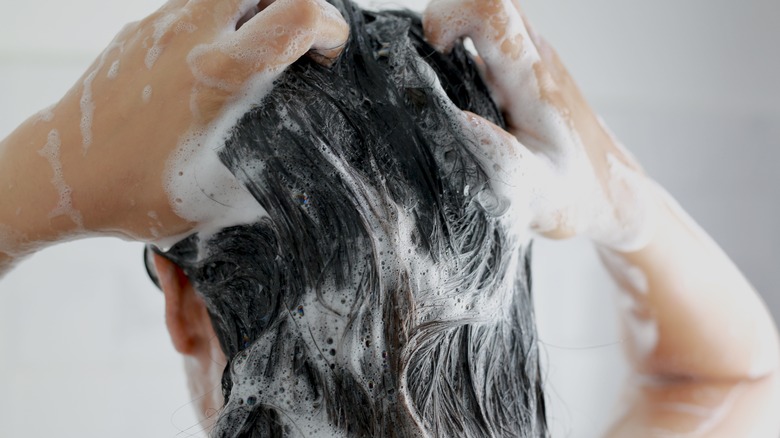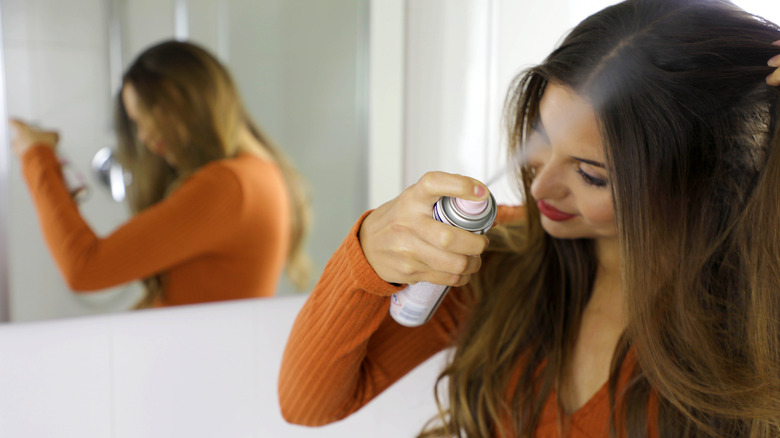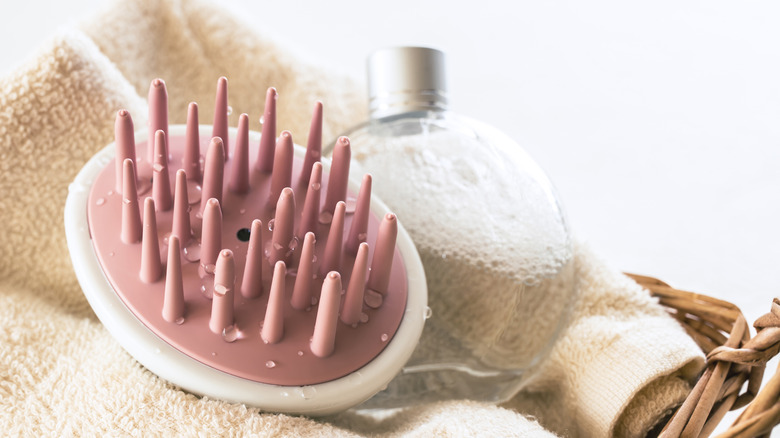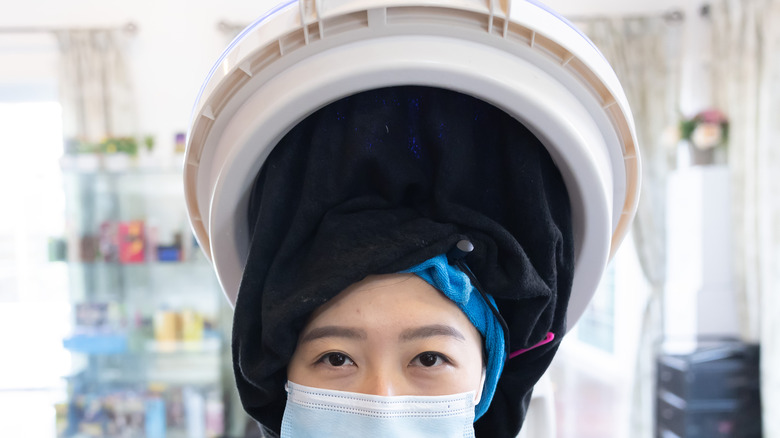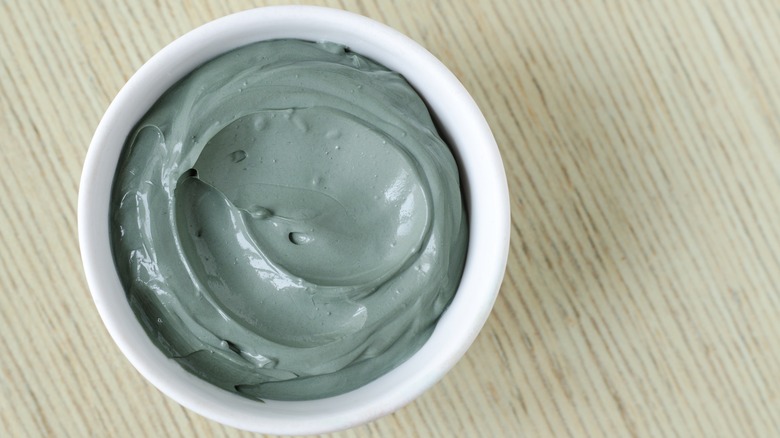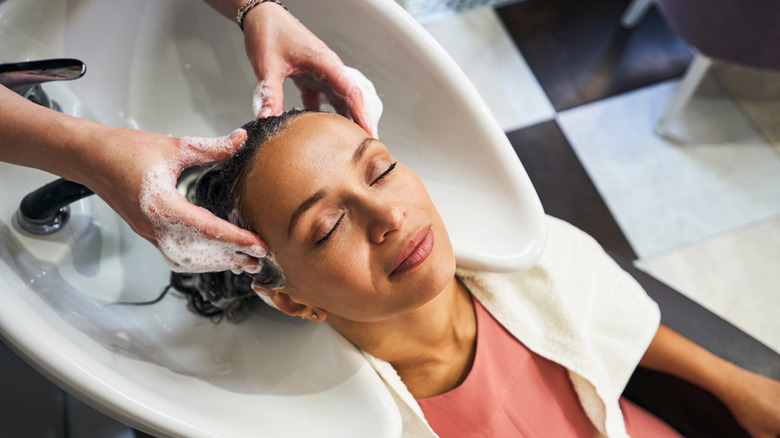7 Ways To Detox Your Scalp For Healthier Hair
Chances are you already have a solid skincare routine, but what about a routine for your scalp? You may not give much thought to the skin on your head, but a neglected scalp can show signs like flakiness, acne, redness, and itchiness (per Healthline). And these problems don't only affect your scalp — they affect the hair growing from it too. "Healthy hair starts with a healthy scalp because it gives your hair the best possible foundation from which to grow," Diane Stevens, a hairstylist and salon owner, explained to PureWow. She recommends tackling scalp and hair issues with a restorative scalp detox.
A detox treatment deep cleans the scalp to tackle buildup and skin issues that can wreck your mane if not addressed. Dr. Brian R. Toy, a dermatologist and clinical professor of dermatology, told U.S. News that detoxes are especially useful for those who regularly rely on hair products and damaging chemical treatments. He says that common hair woes like thinning or oily roots may also be mitigated with a scalp detox.
Even if you don't notice obvious signs of poor scalp health, detoxifying cleanses can remove oil and other gunk that may add up over time. If you've been ignoring the skin on your head, get a start on scalp care with these seven treatments.
Start with a scrub
The first step to detoxing your scalp is to shed product residue, dead skin cells, and excess oil lingering on the skin. Just as you might exfoliate your face or body with a scrub, you can also use a scrub to buff away buildup on your head. WebMD points out two main types of exfoliants: textured and chemical. Store-bought scrubs are generally textured, containing granules of sugar, salt, and other coarse ingredients. Some versions also contain chemical exfoliants, such as salicylic acid.
You can make your scalp scrub using salt or sugar from your cupboard combined with honey, coconut oil, or avocado oil. Gently rub the mixture into your head, making sure to get between the strands of hair. However, steer clear of both commercial and DIY scrubs if you have psoriasis, eczema, or other types of scalp inflammation. "Scrubbing can aggravate the condition and might cause even more flaking and irritation," Dr. Sheel Desai Solomon, a dermatologist, told Well+Good.
Use a clarifying shampoo
Shampoo is essential for maintaining healthy hair and also plays an important role in keeping the skin on your head squeaky clean. And when your regular shampoo just isn't cutting it, a clarifying one can help detox an overworked scalp. What makes clarifying shampoo different, according to Healthline, is its active ingredients. Clarifying products contain strong surfactants that break down grease and grime sitting on the scalp and the roots of the hair. In fact, these ingredients are so strong they might strip the head of healthy oils if used too often.
So what's the right way to detox with a clarifying shampoo? According to Healthline, clarifying shampoo shouldn't be used more than once a week. If you do, your scalp may become dry and flaky, and your mane will likely show signs of damage. Multiple washes may be necessary during deep hair cleaning to help wash away and detox the scalp.
Take a break from heavy products
When you imagine a food detox, you might think of swearing off heavy foods for a few days, opting for juices and cleansing teas instead. Detoxing your scalp can work the same way. Steering clear of the styling products known to cause buildup, at least temporarily, will allow you to make more headway (no pun intended) when detoxing your scalp.
Australia's New York Barbers lists products containing silicones and oils as the worst offenders when it comes to scalp buildup. Additionally, using these products daily is more likely to lead to skin and hair issues than only using them occasionally. Product accumulation is also common if you regularly skip washes. And you might want to think twice before reaching for the can of dry shampoo. Dry shampoo shouldn't take the place of sudsing up your head in the shower, and relying on these products too often can also result in buildup, says Healthline.
Give your head a massage
Detoxing products like scrubs and clarifying shampoos is a good start when deep cleaning your scalp. But to really reap the benefits, you need to work up a little elbow grease and give your head a thorough massage. Lorraine Massey, creator of the Curly Girl Method, suggests a full scalp massage to help release dead skin cells and unclog pores (per Mane Addicts). Vigorously massaging when cleansing promotes blood flow, which boosts scalp health and new hair growth. Work your fingertips into the roots, though be careful not to scratch with your fingernails.
Alternatively, employ the help of an in-shower scrubbing hair tool. These massagers use their soft spikes to slough away dead skin cells and other buildup from the scalp while relieving tension in the head — no finger cramps required.
Massage the scalp with a brush or comb to maintain the effect between detox days. Healthline suggests using a wide-toothed comb, especially for natural hair types, starting at the roots and working your way down. This distributes oils along the hair shaft instead of allowing them to build up on the scalp.
Steam clean your scalp
Steaming is one treatment for your hair you probably haven't tried yet — and no, the steam from your shower doesn't count. This method combines steam from a machine and nourishing moisturizers (think hair oils and deep conditioners) to revitalize sad, damaged tresses. Similarly, it can refresh a dirty, damaged scalp too.
Professional stylist Carlisha Duffey told PureWow, "Deep conditioning using steam gives a client's hair and scalp the best chance at moisture retention, strength, and conditioning—particularly if the hair requires more protein." In short, if scrubs aren't compatible with your sensitive scalp, steaming may be a safe alternative. Besides these benefits, dermatologist Dr. Swati Mohan noted to HealthShots that steaming increases circulation, similar to massaging the head, keeping the scalp and hair strong. To detox your scalp with steam, head to a salon that offers the treatment or use an at-home hair steamer for a similar effect.
Apply a mask
At the end of the day, your scalp is made of skin, just like your face. And sometimes, the products that work in your skincare routine can also work in your scalp care routine—case in point: clay masks. Clay masks are thought to draw out impurities and soak up excess oil — and they can work wonders for scalp health. Bentonite clay is said to be able to remove oil and dirt in addition to moisturizing the skin (per Healthline).
Clay can help define curls and prevent frizz while soothing your scalp. Bridget Hill certified trichologist told Today, "The minerals and natural silica in bentonite clay are highly nourishing and moisturizing, leaving hair hydrated [and] shiny and are ideal in helping to define curly hair."
Clay may also help treat some scalp conditions. Detoxify the skin on your head with a formulated scalp mask product or by making your own. Combine powdered clay with water and apple cider vinegar before applying straight to the scalp and hair.
Visit the professionals
A scalp detox can mostly be done in your bathroom, but for serious results, head to a scalp and hair salon. An expert can survey your skin and roots and choose a treatment with your needs in mind. They may offer more robust solutions if your at-home products don't work.
YouTuber Safiya Nygaard documented her professional scalp cleaning in a 2022 video at a salon specializing in Japanese-style head spa treatments. The process included looking at the scalp with a microscope, cleansing, steaming, applying a mask, and finishing with a scalp serum. However, services may vary by salon, so check with your technician before your visit.
Occasionally, scalp problems may require a trip to the dermatologist, not a salon. Head lice, chronic dandruff, ringworm, and psoriasis are just a few of the scalp conditions that should be treated by a doctor, according to WebMD. If you notice flakes and debris, redness, hair loss, rashes, and other new symptoms that don't go away, call your derm for a diagnosis.
